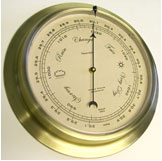

A barometer is a scientific instrument used in meteorology to measure atmospheric pressure. Air pressure is measured in units called millibars. Barometers play a crucial role in predicting weather. High readings on barometers means there is high pressure in the area which means stable weather. When a barometer drops, that means a stormy low pressure cell is moving in.
Barometers measure using two different scales both of which indicate air pressure. One scale measures millibars (mbar) and the other scale measures the amount of mercury (Hg). The amount of mercury can be represented in inches or millimeters. Standard pressure at sea level is 1013.2 millibars or 29.92 inches (760 millimeters) of mercury.
The main use for a barometer is not so much to read pressure, but to measure CHANGES in pressure over time. The barometer normally has two needles, the measuring hand that displays the current pressure and the movable needle called the setting hand. You normally would align the setting hand directly over the measuring hand and then be able to see how much the measuring hand has moved during the day to indicate an increasing or decreasing pressure reading.
On the barometer below the setting hand is drawn in blue and the measuring hand is drawn in red. Determine the measurement of each hand and then decide if the pressure is increasing or decreasing.
![]()
Source: Barometer, Dealers Advantage